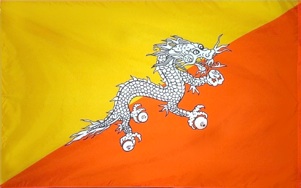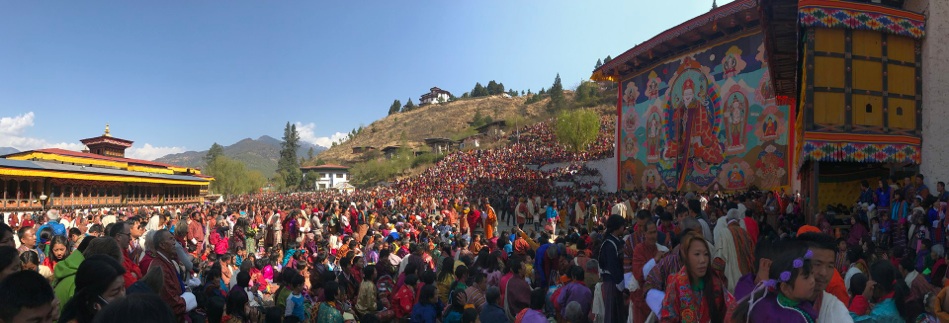Balkans 2016
Balkans 2016 Albania Kosovo Macedonia

Bhutan
2018
The five-day Tshechu Festival is the most important annual event in Paro. Today was the fifth and final day, which is the most auspicious day of all. That is why attending the festival was our one and only plan for the day, and it explains the huge crowds in attendance, including for half an hour or so, the King of Bhutan, Jigme Khesar Namgyel Wangchuck.
The highlight of the final day of the Tshechu Festival is the unrolling of a thongdrol, which is a giant thangka (silk hanging) that covers the entire side of a four-storey monastery building. The word ‘thongdrol’ means ‘liberation on sight’ because simply seeing it is said to confer a blessing. We missed the unrolling, which happened at about 3:30am, the culmination of prayers and rituals that began at midnight (this being the day of the full moon). Traditionally, the thongdrol is rolled up again before dawn, but for each of the last five years or so, the king has visited, and the thongdrol is always left on display until the king’s visit has concluded. Such was the case today, enabling us the comfort of sleeping though the day’s dawn.
The morning was notably colder than yesterday, but the sun was shining as we arrived at Paro Dzong together with what seemed like a hefty proportion of Bhutan’s population. As the most auspicious day of the year, every local person was wearing their finest clothes, and the display of vibrant colours and bright patterns was a marvellous sight to behold.
As we approached the area where we had witnessed the tshechu performances the day before yesterday, two things were immediately apparent. First the thongdrol was covering the side of the building, confirming to everyone that the king would definitely be coming (this is never announced officially beforehand for security reasons). Second, the size of the crowd was far larger than we had experienced two days earlier – not only was the area around the performance field occupied, but all the areas approaching it. This was not a good place for people who don’t like crowds, because this crowd was a big one!
Some performances were already underway by the time we made it through the crowds, but looking down from a nearby hill to the performance area also revealed a large altar with a red carpet leading to and from it. Kings like walking on red carpets, so this was further confirmation (if any was needed) that indeed the king would be present today.
After taking in an overview of the area from the hill, I descended down to the main field, but was soon stopped by a cordon of scouts whose job it was to defend the red carpet that was running across the grass field. The word was out – the king had arrived and would soon walk by us. We were also told in no uncertain terms that hats must not be worn and no photographs could be taken of the king.
And so it is that I was standing just a metre or so from the King of Bhutan as he walked by me, my hat and camera both held low as we exchanged smiles and nods.
Once the king had departed, it was possible for members of the public to venture up to the altar, where they were able to take brightly coloured crackers and what looked like wafer-thin prawn chips. This also gave them the opportunity to approach the thongdrol and have a very close look at it.
No-one knows how old the Paro thongdrol is, but estimates suggest it is between 300 and 400 years old. Given its age, the colours were surprisingly bright and vibrant. At about 9:30am, the thongdrol was lowered, ceremonially rolled up, and placed in a wrapping that was surprisingly small given the immense size of the hanging. It was then carried away to be stored until next year’s tshechu.
This important task completed, the performances began in earnest. Whereas the performances two days ago were largely dramatic in nature, todays’ performances were more overtly religious and ceremonial.
A combination of monks and lay folk dressed in elaborate silk brocade costumes performed several dances with the common theme of good triumphing over evil to the accompaniment of haunting sounds from long trumpets, cymbals and flutes. The dances and costumes have survived unchanged for many centuries, and each dance was a precise re-enactment of visions seen by Bhutan’s great Buddhist saints in which any changes made by the performer would be viewed as sacrilege. Among the dances performed were ‘Lords of the Cremation Grounds’, ‘Terrifying Deities’, ‘Heroes’, ‘The Eight Manifestations of Guru Rinpoche’, ‘Dance of the Sixteen Fairies’, and ‘Religious Song’, with the performances interspersed with folk songs and clowning.
In between two of the performances, attendees were invited to come forward and receive blessings from the monks, and this resulted in a mass throng of people that took a couple of hours to process. All this time, the dancing and the music continued in a form that would have been almost hypnotic if it were not for the thousands of people (literally!) that were in the crush of humanity winding its way past the performance area.
Although the morning began warm and sunny, the weather deteriorated as the day proceeded, and by mid-afternoon the overcast skies and cold wind that felt as though it was blowing directly off snow degenerated further to light showers of rain. Perhaps the weather explains why the crowds were dispersing markedly as the day went on, and by the time the ceremonies ended at 3:30pm, we were part of a tiny remnant of a crowd that was perhaps just 2% to 3% of the numbers attending in the morning while the thongdrol was on display.
We spent the rest of the afternoon exploring Paro town, as this was our last opportunity to do so before setting off to the east early tomorrow morning. Paro town is architecturally marvellous despite its small size, with two and three storey buildings constructed in traditional Bhutanese style, including the beautiful intricate paint details that seem to adorn every building we have seen. It was cold, damp, but very enjoyable ending to a very special day.

Day 3 - Paro
Saturday 31 March 2018














